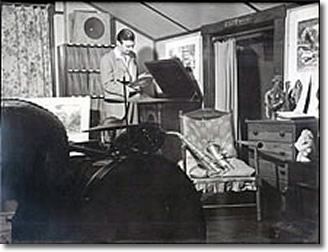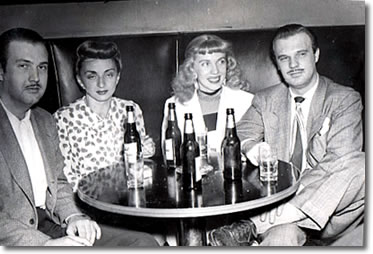Tristan Meinecke: home recordings, 1939-1943. (Vinyl Freak).(work of talented painter/musician considered)
Down Beat, June, 2003, by John Corbett
This month, think of me as the "Acetate Freak." Before WWII, when people wanted to record themselves, they might have done so directly onto disc. These old home records might be one- or two-sided; 12, 10 or the quickly obsolete 5 inches in diameter; and they tend to hold up better than many magnetic tapes.
Recently, I've auditioned some acetates from the early '40s documenting the music of important  Chicago painter Tristan Meinecke. These recordings offer proud testimonial to the way that jazz was presumed to be the most relevant music in virtually all arts communities. Indeed, Meinecke's story shows how fuzzy the borders between the visual arts and jazz were, and how strong the allure of improvisation was to a modern-minded artist. Chicago painter Tristan Meinecke. These recordings offer proud testimonial to the way that jazz was presumed to be the most relevant music in virtually all arts communities. Indeed, Meinecke's story shows how fuzzy the borders between the visual arts and jazz were, and how strong the allure of improvisation was to a modern-minded artist.
Looking back, Meinecke calls himself "a latecomer to jazz." He first learned about it around 1928, when he was 12. At the time, growing up in the suburbs of Ann Arbor, Mich., he'd listen to Cab Calloway on the radio. In '32, he moved to Ann Arbor, and at 19 he got a clarinet. He taught himself to blow while sick in bed, then took a few lessons from the leader of the Michigan band from whom he learned basic fingerings. Eventually he got tired of the instruction and committed to teach himself by ear.
In Ann Arbor, Meinecke met Harvey Brown, the guitar playing brother of Chicago alto saxophonist Boyce Brown. They jammed regularly, drinking gin and raising a ruckus. Together with his drumming/trumpet-playing brother Phil (see inset painting, "Phil & Tom-Tom," 1942), seven years his junior, Meinecke canvassed the small black section of town for unwanted jazz and blues 78s, collecting shellacs by Ma Rainey, Bessie Smith, Louis Armstrong, King Oliver and various members of Chicago's Austin High Gang. Meinecke aspired to play like Johnny Dodds, Mezz Mezzrow and Pee Wee Russell. But where Russell was a massive clarinetist who was also a very good painter, Meinecke probably could have gone either way. He's a visionary visual artist and a natural musician--that he never practiced the clarinet is hard to fathom listening to the slinky sound and bottomless trove of melodic ideas on these acetates.
All of them were recorded in Ann Arbor, before the Meinecke brothers relocated to Chicago in '43. The earliest is a 5-inch from '39, with Phil on drums, "Tom" on guitar and Jim Bridges on terrific trumpet. One from '40 was recorded live with a band of professional musicians at the exclusive Barton Hill Country Club. There are some music-minus-one style recordings featuring a lithe Phil on trumpet and Tristan's confident clarinet. A bouncy version of "Coquette" from two years later is backed by a grinding blues, as is a roughly recorded version of "Sheik Of Araby." A 5-inch from '42 spotlights Phil's Bix-like trumpet, duetting with Tristan on brushes and snare.
In the Windy City, Meinecke found lots of opportunities to play. Earl Hines' clarinetist Darnell Howard, with whom Meinecke and his wife, Lorraine (television's Angel Casey), were friends, gave him a new mouthpiece. Years later, after Phil had tragically taken his own life, Tristan worked out intriguing pieces for solo piano and electric piano, highly chromatic things he referred to as "atonal compositions," as well as forays into musique concrete. These early-'60s tape recordings seem distant from the legacy of his hot jazz days until you listen to the short extra track on one of the '43 acetates: There's Tristan, alone on piano, testing out an incredibly advanced harmonic idea, presaging his own subsequent investigations.
E-Mail the Vinyl Freak: vinylfreak@downbeat.com
More than 60 years separate the first jazz recording in 1917 and the introduction of the CD in the early '80s. In this column, DB's Vinyl Freak unearths some of the musical gems made during this time that have yet to be reissued on CD.
COPYRIGHT 2003 Maher Publications, Inc. in association with The Gale Group and LookSmart.
COPYRIGHT 2003 Gale Group |

